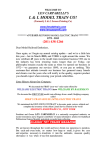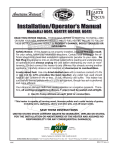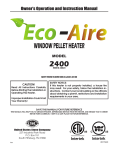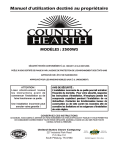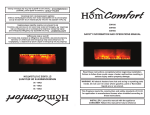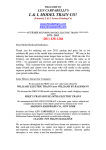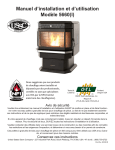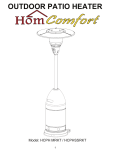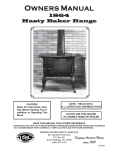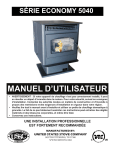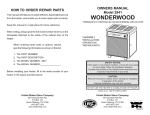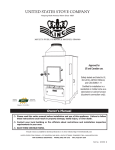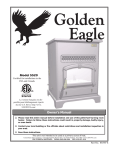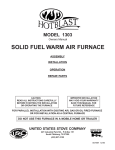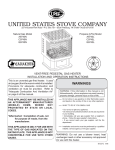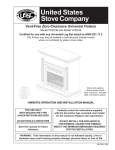Download United States Stove CSSU User's Manual
Transcript
Owners Manual 1869 Caboose Potbelly CAUTION! Read All Instructions Carefully Before Starting The Installation or Operating This Stove. NOTE: THIS IS NOT A U.L. LISTED COAL BURNING STOVE DO NOT USE THIS HEATER IN A MOBILE HOME OR TRAILER SAVE THIS MANUAL FOR FUTURE REFERENCE STATES STO TED V NI USSC COMPANY E U THIS MANUAL WILL HELP YOU TO OBTAIN EFFICIENT, DEPENDABLE SERVICE FROM THE HEATER, AND ENABLE YOU TO ORDER REPAIR PARTS CORRECTLY. KEEP IN A SAFE PLACE FOR FUTURE REFERENCE. UNITED STATES STOVE COMPANY 227 Industrial Park Road P.O. Box 151 South Pittsburg, TN 37380 (423) 837-2100 Keeping America Warm since 1869 851499 Illustrations 15" STOVE DIMENSIONS FIGURE 1. 36" FLOOR PROTECTOR 19.5" 21.6" (FRONT VIEW) (SIDE VIEW) Specifications Height (Overall)...................................... Width...................................................... Depth...................................................... Firebox Capacity.................................... Firebox Depth......................................... Flue Size................................................. Door Opening......................................... 36" 21.6" 19.5" 40 lbs. 10" 6" 8" x 10" Material............................................ 100% Cast Iron Fuel.................................................................... Coal NOTE: Bituminous, large nut to small egg or Anthracite, large egg to small broken. BTU Rating.................................................. Weight......................................................... This stove has an oval flue outlet and uses standard 6" stovepipe. Ill. 1 To attach pipe, simply hand form the smooth end of the round stove pipe into an oval shape. Ill. 2 Slide the crimped end of the stove pipe into the oval flue outlet and secure with metal screw. Connect balance of stove pipe into a class A chimney Ill. 3 2 200,000 216 lbs. CONGRATULATIONS! You have purchased a heater from North America's oldest manufacturer of wood and coal burning products. Our Caboose Potbelly Stove is reminiscent of the potbelly stoves seen in the train stations and cabooses of yester year. This high performance potbelly stove is constructed of all cast iron and is designed to burn coal. Its generous firepot capacity with shaker grate allows 40 lbs. of coal to burn for eight hours before requiring refueling. Separate ash door with slide draft control at bottom creates a "forge effect" that insures proper combustion. Long flared top with 8" lift out lid facilitates fry pan or tea kettle. Stove comes assembled except for legs. Safety Rules SAFETY NOTICE: If this heater is not properly installed a house fire may result. For your safety, follow the installation directions. Contact local building or fire officials about restrictions and installation inspection requirements in your area. Read these rules and the instructions carefully. 1. The installation of this stove must comply with your local building code rulings. Please observe the clearances to combustibles. (Refer to Figures 2 and 3) Stove must be 36" from a combustible wall (wood or plaster board) at rear or sides. 2. DO NOT install this stove in a mobile home or trailer. 3. Always connect the stove to a chimney and vent to the outside. Never vent to another room or inside a building. 4. DO NOT connect a wood burning to an aluminum Type B gas vent. This is not safe and prohibited by the NFPA (National Fire Protection Agency) This stove requires approved masonry or a UL 103 HT Listed Residential Type and Building Heating Appliance Chimney. Use a 6" diameter chimney or larger, that is high enough to give a good draft. 5. Be sure that your chimney is safely constructed and in good repair. Have the chimney inspected by the fire department or a qualified inspector. Your insurance company may be able to recommend a qualified inspector. 6. Creosote or soot may build up in the chimney connector and chimney and can cause a house/building fire. Inspect the chimney connector and chimney twice monthly during the heating season and clean as necessary. (See Chimney Maintenance, page 6) 7. Provide air for proper combustion from outside the house into the room where the stove is located. If the intake is not in the same room, air must have free access to the room. 8. To prevent injury, do not allow anyone to use this stove who is unfamiliar with the correct operation of the stove. 9. For further information on using your stove safely, obtain a copy of the National Fire Protection Association publication "Using Coal and Wood Stoves Safely" NFPA No. HS-10-1976. The address of the NFPA is Batterymarch Park, MA, 02269. 10. Dispose of the ashes in a metal container with a tight fitting lid. Keep the closed container on a non-combustible floor or on the ground, well away from all combustible materials. Keep the ashes in the closed container until all cinders have thoroughly cooled. The ashes may be buried in the ground or picked up by a refuse collector. 11. The special paints used on this stove may give off some smoke and an odor while they are curing during the first few fires. Paint discoloration will occur if the stove is overfired. 12. This stove has a painted surface which is durable but it will not stand rough handling or abuse. When installing your stove, please handle with care. Clean with soap and warm water when stove is not hot. Do not use any acids or scouring soap, as the will wear and dull the finish. 13. While the stove is in operation, all persons, young children especially, should be alerted to the hazards from high surface temperatures and should keep away to avoid burns or clothing ignition. Small children should be carefully supervised when they are in the same room with the stove. 14. Keep stove area clear and free of all combustible materials such as gasoline and/or other flammable vapors and liquids 3 Assembly and Installation 1. Uncrate and/or unpack the heater, removing all packing material, being careful not to dispose of the Parts Bag. 2. Remove the following contents: A. (4) Legs with nut and bolt package B. (1) Lid with (1) Lid Lifter C. (1) Shaker Grate D. (1) Ash Door with (1) Slide Draft E. (1) Feed Door 3. Carefully lay the stove on its side, preferably on a soft surface. Note: Cardboard shipping carton placed flat works well for this application. 4. Securely attach all four (4) legs to lower chamber using nut and bolt package. 5. Carefully return stove to upright position and place it in desired location. 6. Place lid in position on top plate. 7. Position ash door with slide draft on front of lower chamber. 8. Place shaker grate in lower chamber. MINIMUM CLEARANCE TO COMBUSTIBLE WALLS 18" (60" MIN.) 39-1/2" (51-1/2") 38" (44") 36" (48") 42" (48") FLOOR PROTECTOR 14-1/2" FIGURE 2 FLOOR PROTECTOR 10-1/4 FIGURE 3 Clearances in () are for Canada ONLY. HEATER/FLOOR PROTECTOR LOCATION DASHED LINES SHOW STRAIGHT OUT CHIMNEY CONNECTOR Place the heater on solid masonry or solid concrete. When the heater is used on a combustible floor, use an Underwriters Listed floor protector. The floor protector must comply with UL Standards. The base should extend at least 18" beyond the door side of the heater and should extend under the flue pipe if it is elbowed towards a wall. (Fig. 4). 1. The stove must have its own flue. Do not connect this unit to a chimney flue serving other appliances. 2. After observing the clearances to combustibles, locate your floor protector accordingly and carefully place the stove in your selected location. Install stove pipe , elbows and thimble as necessary, utilizing either a recently cleaned and inspected masonry chimney or a UL 103 HT Listed Residential Type and Building Heat ing Appliance Chimney. 3. NON- COMBUSTIBLE CONSTRUCTION IN ACCORDANCE WITH NFPA 211 28" 54" FLOOR PROTECTOR If your chimney continues to draft excessively, then use a Barometric Draft Regulator. 4. Use three (3) sheet metal screws in each stove pipe and /or elbow joint to firmly hold the stove pipe together. Use 6" round black/blue stove pipe, not galvanized stove pipe . 5. Recheck illustrations Fig. 2 through 7 to be sure you have the proper clearances shown from the stove and the connector pipe to combustible surfaces. NOTE: If a wall is only faced with brick or stone, consider it as a combustible wall. 36" FIG. 4 RIGHT WRONG WRONG FIG. 5 6. DO NOT install this stove in a mobile home or trailer. 7. If you have too much draft, then install a 6" cast iron stove pipe damper in the first joint of the stove pipe. CAUTION! KEEP FURNISHINGS AND OTHER COMBUSTIBLE MATERIALS AWAY FROM THE HEATER. 4 Chimney Connection MASONRY CHIMNEY The masonry chimney must comply with UL codes. Before using an existing masonry chimney, clean the chimney and inspect the flue liner to be sure it is safe to use. Make repairs before attaching the heater. See Page 3, Item 5. Look at Fig. 5. The connector pipe and fittings you will need to connect directly to a masonry chimney are shown. If the connector pipe must go through a combustible wall before entering the masonry chimney, consult a qualified mason or chimney dealer. The installation must conform to local fire codes, and NFPA 211. Do not connect this heater into the same chimney flue as the fireplace or flue from another heater. The chimney used for a heater must not be used to ventilate the cellar or basement. If there is a cleanout opening at the base of the chimney, close it tightly. UL LISTED CHIMNEY Carefully follow chimney manufacturer's instructions. Use only listed type HT per UL 103, 6-in diameter black or blued chimney connector, minimum 24 gauge steel. If your chimney starts at the ceiling (Fig. 7), you will need enough 6" pipe to reach the ceiling. The top of the chimney must be at least 3 feet above the roof and be at least 2 feet higher than any point of the roof within 10 feet. (Fig 7) FLUE CONNECTION-NON-COMBUSTIBLE WALL RULES FOR CONNECTOR PIPE INSTALLATION 1. 2. 3. 4. 5. 6. 7. Crimped end of the pipe must be installed away from the heater. The pipe must be hand formed to an oval shape which should slide on the collar top. The pipe should be firmly attached to the collar top with 3 screws and sealed with furnace cement. Slope any horizontal pipe upward toward the chimney at least 1/4 " inch for each foot of horizontal run. You must have at least 18" inches clearance between any horizontal piping and the ceiling. (Fig. 3) The pipe cannot extend into the chimney flue.(Fig. 5) Seal each connector pipe joint with furnace cement. Also seal the pipe at the chimney. Use 3 sheet metal screws at each joint to make the piping rigid. It is recommended that no more than two (2) 90 degree bends be used in the stove pipe installation as more than two (2) may decrease the amount of draw and possibly cause smoke spillage. NON-COMBUSTIBLE WALL THIMBLE COLLAR ELBOW PIPE BAROMETRIC DRAFT REGULATOR PIPE FIG. 6 NOTE: The chimney connector shall not pass through an attic, roof space, floor, ceiling, or similar concealed space. Where passage through a wall or partition of combustible construction is desired, the installation must conform with NFPA 211. FLOOR PROTECTOR Operation of the Stove CHIMNEY CAP MANDATORY 1. Fully open slide draft on ash door and keep spin damper on feed door closed. 2. Burn wood or coal only. The wood should be air dried (seasoned) for at least 6 months after cutting. Build six (6) small fires upon initial firing. Light wood or coal using paper, twigs, etc. 3. After the fire has been started and is burning satisfactorily, close slide draft almost all the way. 4. Open/adjust spin draft on feed door to allow additional air into the stove (on top of the fire). This will allow a more efficient burn cycle. 5. Never build extremely large fires in this type stove as damage to the stove or smoking may result. 6. DO NOT touch the stove after firing 7. Never overfire this stove by building excessively hot fires as a house/building fire may result. 8. Inspect stove pipe every 90 days. Replace immediately if stove pipe is rusting or leaking smoke into the room. 9. This is a cast iron stove. It does not have welded seams. From time to time you may have to "tune-up" the stove by refilling and/or replacing the stove cement or mortar along the seams. 10. If stove begins to glow or turn red, you are overfiring. 2 FT. MIN 10 FT. PIPE REDUCER 11 FT. MINIMUM BAROMETRIC DRAFT REGULATOR PIPE FIG. 7 FLOOR PROTECTOR 5 3 FT. MIN. NON-COMBUSTIBLE CONSTRUCTION IN ACCORDANCE WITH NFPA 211 WARNING! NEVER STORE FLAMMABLE LIQUIDS, ESPECIALLY GASOLINE. IN THE VICINITY OF THE HEATER. CAUTION! NEVER USE GASOLINE, GASOLINE-TYPE LANTERN FUEL, KEROSENE, CHARCOAL LIGHTER FLUID, OR FLAMMABLE LIQUIDS TO START OR "FRESHEN UP" A FIRE IN THE HEATER. CAUTION! OVERFIRING THE APPLIANCE MAY CAUSE A HOUSE FIRE. IF A UNIT OR CHIMNEY CONNECTOR GLOWS, YOU ARE OVERFIRING. CAUTION! USE COAL ONLY. DO NOT USE DRIED LUMBER, TREATED WOOD ARTIFICIAL OR PRESSED LOGS. WARNING! NEVER OPERATE THIS HEATER WITH THE FUEL DOOR OPEN. WARNING! DO NOT OBSTRUCT THE SPACE BENEATH THE HEATER Service Hints Do not expect a heater to draw. It is the chimney that creates the draft. Smoke spillage into the house or excessive buildup of water or creosote in the chimney are warnings that the chimney is not functioning properly. Correct problem before using heater. Possible causes are: 1. The connector pipe may push into the chimney too far, stopping the draft. (Fig. 5) 2. Do not connect two heaters into the same chimney flue. 3. The chimney used for a heater must not be used to ventilate the cellar or basement. If there is a cleanout opening at the base of the chimney, It must be closed tightly. 4. If the chimney is operating too cool, water will condense in the chimney and run back into the stove. Soot formation will be rapid and may block the chimney. Operate the heater at a high enough fire to keep the chimney warm preventing this condensation. 5. If the fire burns well but sometimes smokes or burns slowly, it may be caused by the chimney top being lower than another part of the house or a nearby tree. The wind blowing over a house or tree, falls on top of the chimney like water over a dam, beating down the smoke. The top of the chimney should be at least 3 feet above the roof and be at least to 2 feet higher than any point of the roof within 10 feet (Fig. 7). Chimney Maintenance The chimney connector and chimney should be inspected at least twice monthly during the heating season to determine if a creosote or soot buildup has occurred. If there is any accumulation, it should be removed. Failure to remove creosote may cause a house fire. Soot may be removed by using a chimney brush or other commonly available materials. Chimney fires burn very hot. If the chimney connector should glow red, immediately call the fire department, then reduce the fire by closing the inlet air control and pour a large quantity of coarse salt, baking soda or cool ashes on top of the fire in the firebox. CAUTION: A chimney fire may cause ignition of wall studs or rafters which you thought were a safe distance from the chimney. If you have a chimney fire, have your chimney inspected by a qualified person before using again. CAUTION! Do not touch the heater until it has cooled. NOTE: FOR YOUR SAFETY, WE RECOMMEND INSTALLING SMOKE DETECTORS IN YOUR HOME IF NOT ALREADY INSTALLED. 6 Model 1869 Repair Parts 16 15 1 2 14 3 13 12 4 11 5 10 6 9 8 7 KEY PART NO. DESCRIPTION QNTY. 1 2 3 4 5 6 7 8 9 10 11 12 13 14 15 16 89979 89980 89981 89982 89983 89984 89985 89986 89987 89988 89989 89990 89991 89992 89993 89994 TOP PLATE UPPER CHAMBER FEED CHAMBER BURN CHAMBER LOWER CHAMBER BASE LEGS ASH DOOR SLIDE DRAFT SLIDE DRAFT KNOB SHAKER GRATE SPRING HANDLE FEED DOOR SPIN DRAFT COLLAR TOP COOK LID 1 1 1 1 1 1 4 1 1 1 1 1 1 1 1 1 * NOT SHOWN 7 HOW TO ORDER REPAIR PARTS THIS MANUAL WILL HELP YOU OBTAIN EFFICIENT, DEPENDABLE SERVICE FROM THE HEATER, AND ENABLE YOU TO ORDER REPAIR PARTS CORRECTLY. KEEP IN A SAFE PLACE FOR FUTURE REFERENCE. WHEN WRITING, ALWAYS GIVE THE FULL MODEL NUMBER WHICH IS ON THE NAMEPLATE ATTACHED TO THE BACK OF THE HEATER. WHEN ORDERING REPAIR PARTS, ALWAYS GIVE THE FOLLOWING INFORMATION AS SHOWN IN THIS LIST: 1. The PART NUMBER 2. The PART DESCRIPTION 3. The MODEL NUMBER: 1869 4. The SERIAL NUMBER: UNITED STATES STOVE COMPANY 227 Industrial Park Road P.O. Box 151 South Pittsburg, TN 37380 (423) 837-2100 www.USSTOVE.com









